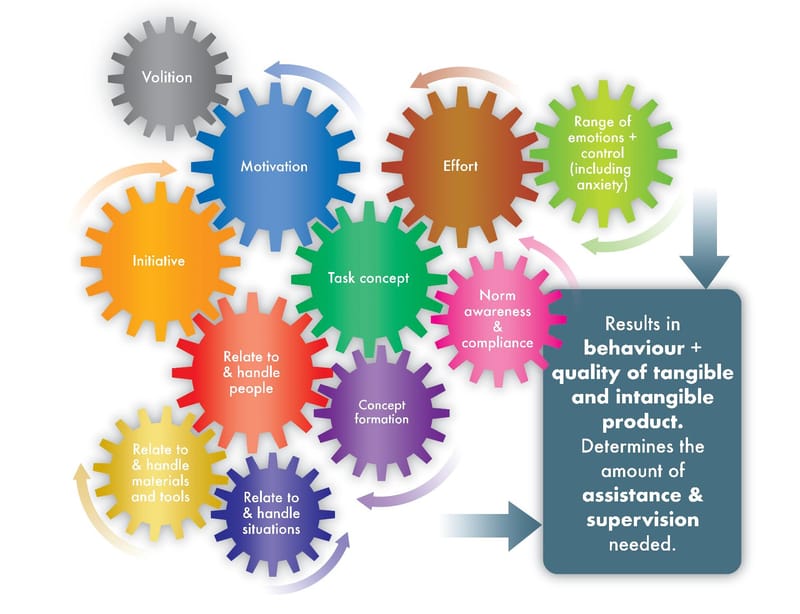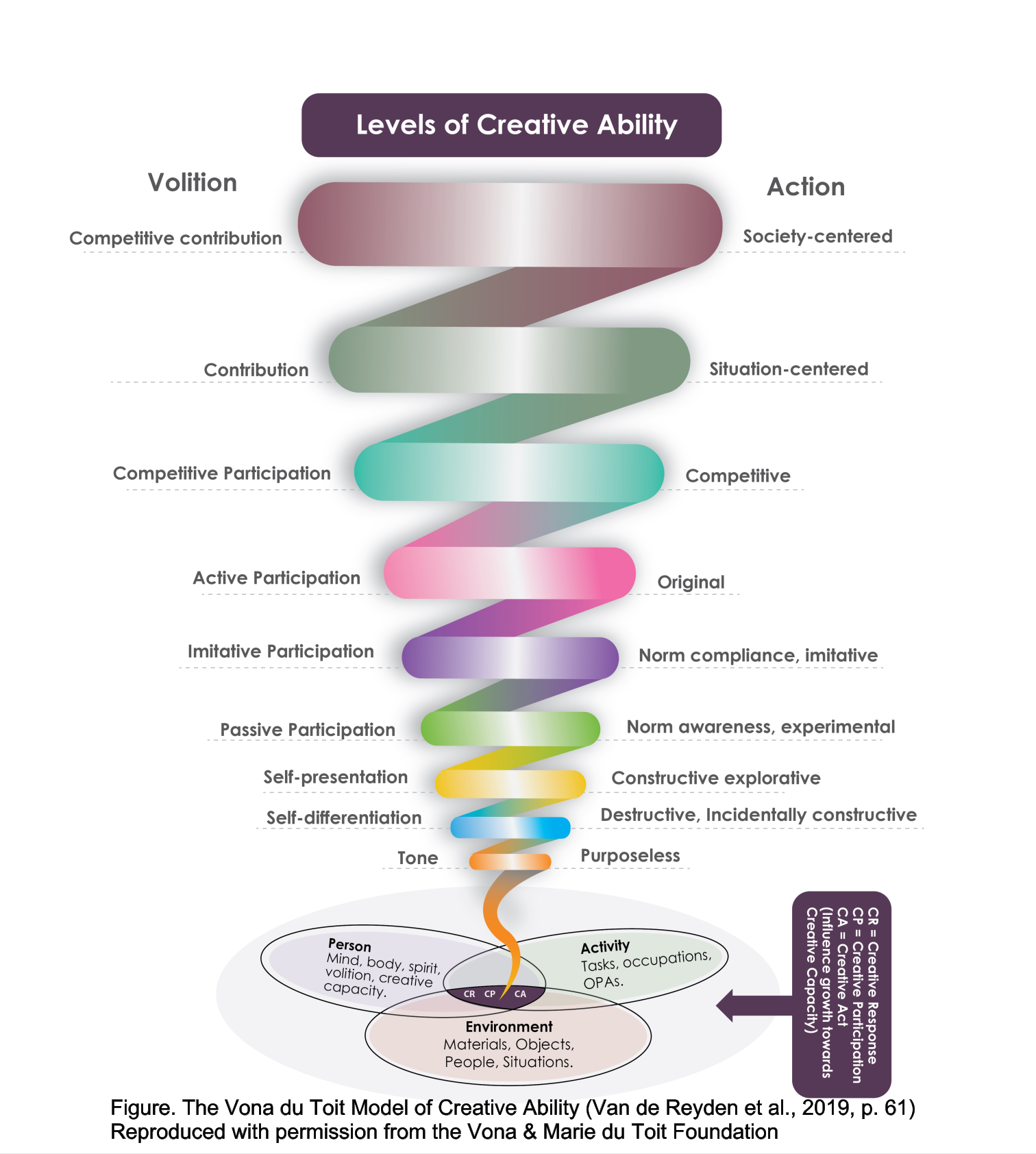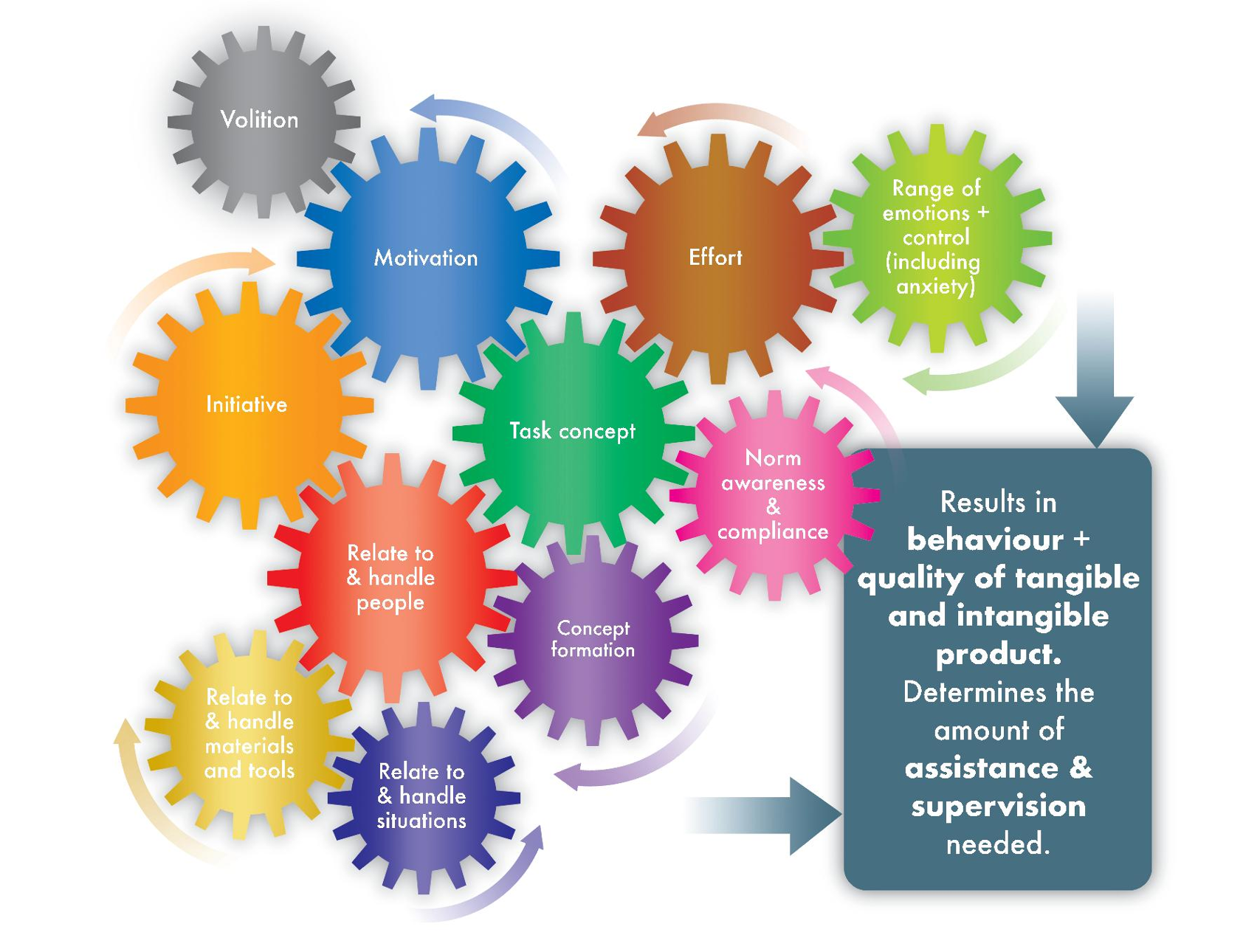Assessment of creative ability and outcome measurement

When using the VdTMoCA, the therapist seeks to understand the person holistically (mind, body, spirit / volition).
It is important to gain an understanding of a person's past as this not only provides invaluable information on them as an occupational being / occupational profile, but indicates what levels of creative ability have been experienced so far and under what conditions (the person-environment-occupation dynamic) - how did this person become who they are? This information can provide an indication of what levels the person can potentially access again and/or recover to, depending upon current circumstances.
Assessment is in all four occupational performance areas (Personal Management, Social ability, Work ability, Constructive use of free time). The therapist seeks to identify what level of creative ability the person is on now, and the P-E-O influences on creative ability, i.e. the interaction between the three aspects at the base of the model's graphic.
An individual can be on a different level and/or phase in different occupational performance areas, therefore the therapist uses clinical reasoning to identify what level and phase the person is overall (the majority of the time). The overall level provides a baseline and indication of the level at which to pitch most interactions/interventions, but the therapist may still work with the person at a different level or phase when engaging them in some occupational performance area specific activities.
Assessment methods
Assessing an individual in order to identify his/her/their level of creative ability requires observation of the person doing as many different activities as possible across the occupational performance areas (Personal Management, Social ability, Work ability, Constructive use of free time).
Activities should be both familiar and unfamiliar activities. The latter are important in order to see all of the occupational performance components (components of creative ability) (Fig. 1):
- volition and motivation
- task concept (and concept formation)
- initiative and effort
- Relational contact with materials, objects, people, situations
- norm awareness and compliance
- behaviour
- range of emotions and control, including anxiety
plus - quality and amount of support/supervision, and the quality of tangible and intangible products.

Figure 1. Components of creative ability. Original image by Sherwood (2016), reproduced by Van der Reyden & Sherwood (2019), p.86.
These are the components essential to one's creative ability, and are specifically assessed. Not all of these are demanded of when doing familiar activities, e.g. problem-solving, frustration tolerance and effort. Familiar activities can become habituated and done almost without consciously thinking about them - this is habituated action which does not adequately show a person's creative ability - ability to bring about something new. Habituated action also doesn't necessarily require effort and strength of volition and motivation - these are essential to observe as creative ability is one's volition expressed in action, through effort. We want to know - what is this person's drive (volition, will power) directed towards - what really sparks them into action, fully engages them to meet a need (which is what drives the volition)? So, we need to observe a person doing familiar and unfamiliar activities - what activities/tasks that they do provides an indication of what they have motivation for, but more importantly, how (the quality of their performance), and why they do those activities (what is their volition directed towards?), and how much support/structure/supervision they need.
These observations are called task assessments - activity-based assessment.
Task assessment using unfamiliar activities are carefully selected and graded so that they:
1. enable the therapist to assess all the components of creative ability: effort, initiative, task concept (includes cognitive skills for doing tasks), concept formation ability to make relational contact with materials, objects/tools, people and situations, range of emotions and control of emotions especially anxiety and behaviour. The amount of support and supervision that a person needs in order to do, and the quality of their end-products is also observed and are indicators of a person's level of creative ability.
2. enable the person to show their level of creative ability, i.e. the therapist grades the activity so that it is being pitched at the level of creative ability which the client is thought to be on, but poses a challenge to the client. This is so that the activity is engaging (meets their volitional need), is doable (not too difficult but within their ability), but requires effort and therefore gives the client the opportunity to show strength of volition and motivation and how much creative ability they have, i.e. how much can they do before activities are too challenging and beyond their current level of creative ability. In this respect, it's a very positive approach to assessing as we are seeking to enable clients to show us their full potential at this moment, without failing at activities. Unfamiliar activities are particularly good for seeing a person's actual level of creative ability rather than habituated action - the latter can make a person appear much more able/be of a higher level of creative ability than they are.
Interviewing is also an important assessment method - whether formal interviews or more casual discussion and conversation. Formal interviews or lengthy discussion is not possible with clients on the first two levels of creative ability, therefore is not an assessment method used with every client. There is no interview guide - therapists seek to gain information on a person's activities/occupations and routine across the occupational performance areas, what they enjoy, find difficult, wish to do etc etc - everything in the OT domain of concern. Attention is paid to hearing the person's level of volition in the information they provide - what do they have strong will and motivation for, and what doesn't get done or done adequately, not due to lack of functional ability but due to lack of drive?
Similar information is also gained from others if possible - collateral information.
Finally, observing the person with other people is very important, especially in a group situation (termed a social evaluative group), in order to assess Social ability.
The service context, client group and especially their levels of creative ability influences how therapists undertake assessment of creative ability - a therapist could not assess a person on the Self-differentiation level of creative ability in the same way as a person on a different level, and every person is unique therefore one is unlikely to assess every client in the same way even when they are all on the same level. Therefore the assessment is not standardised.
Concluding the level and phase of creative ability
Assessment findings are recorded on the Creative Participation Assessment form (Van der Reyden et al, 2019). Occupational Therapists use their knowledge of the levels and phases of creative ability and the components of creative ability in order to select descriptors on the form which best describe the client. Descriptors are of each component of creative ability, and of the person's volition and overall action. This is not a tick box exercise, but recording of carefully clinically reasoned assessment findings. Interpretation of the findings leads to identifying the person's overall level of creative ability, and therapists can also record the phase of creative ability. This process if the responsiblity of Occupational Therapists only - it should never be undertaken by other disciplies or OT Support Workers. Their knowledge and feedback contributes to the assessment information, but they do not complete the form or conclude the level and phase.
The assessment findings are a baseline measure, indicating the level which the therapist should grade intervention to, including their communication and interaction with the client. As therapists work with clients, they adjust their intervention according to changes in the client's level or phase of creative ability - creative ability is dynamic and changes according to changes in the relationship between the person-environment/situation/context including the people therein- and activity/task/occupation. It is not unusual for a person to have slightly higher or lower creative ability in one or more occupational performance areas than the others. Understanding how and why a person's creative ability changes enables therapists to pitch intervention accordingly - perhaps grade activities to place high demands on task performance, but not high social demands because the person is on a lower level of creative ability for Social ability than for Work ability. Therefore, the social aspect of an activity is graded to that level to enable successful interaction and growth in this aspect.
Outcome measurement
The assessment form can be completed as often as is suitable, providing an outcome measure. Many therapists only use the CPA assessment form - it is a measure and can be used for interim measurement and the final outcome measure.
The Activity Participation Outcome Measure (APOM) (Casteleijn, 2010) can also be used. The APOM was developed based upon the levels and phases of creative ability, measuring in 8 domains. The domains and the items therein were identified from research into what mental health clients thought OTs should measure as well as gaining OTs' perspectives (Casteleijn & Graham, 2012a, 2012b). Although the APOM was developed for use in mental health, it is proving valuable in the field of learning disabilities, traumatic brain injury and other fields.
The APOM is a large measure of 53 items and requires more than novice level knowledge of the VdTMoCA in order to competently use it. Therapists need to not only be competent in assessing creative ability (which takes a long time to learn), but also confident in their knowledge of the levels and phases of creative ability as every item on the APOM has to be scored not only by level, but the phase of the level. The difference in the phases of creative ability also takes time to know. The Creative Participation Assessment is essential to practice as it identifies a person's level and phase, indicating why the individual is presenting on that level. This is assessment and should not be replaced with the APOM which is an outcome measure.
Training in the APOM is required to use it and a license is required. Contact daleencasteleijn61@gmail.com for details.